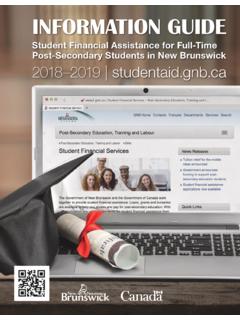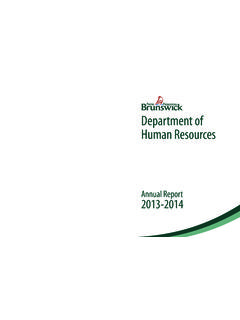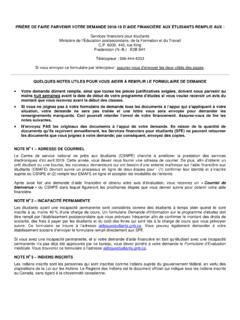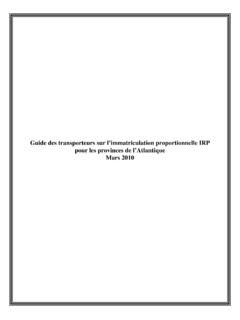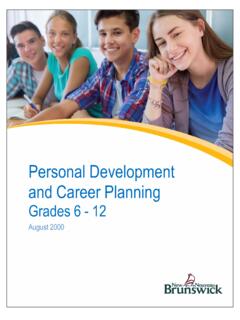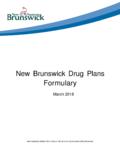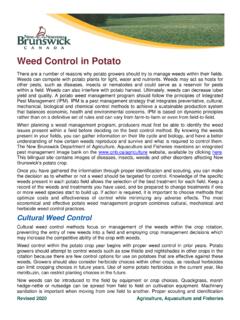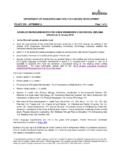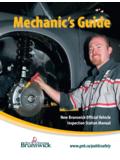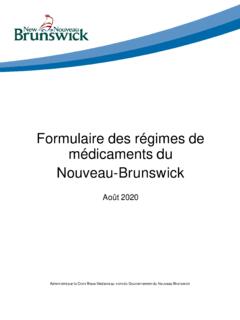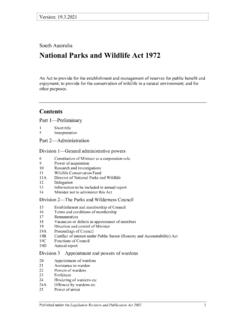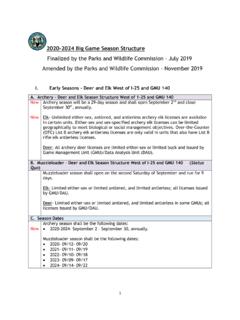Transcription of Hunt & Trap 2021 - gnb.ca
1 Hunt & Trap2021 Aboriginal and Treaty RightsThe Mi gmaq, Peskotomuhkati (Passamaquoddy), and Wolastoqey (Maliseet) Peoples have sustained their families and communities in New Brunswick for thousands of years. At the time of contact with European settlers they had vibrant cultures with economies based on the use and trade of plants, fish, seafood, and wildlife , supported by land and water networks connecting camps, villages, and spiritual places. Their relationship with the land has always been one of respect, reciprocity, and conservation of natural Aboriginal Peoples of North Eastern North America signed Peace and Friendship Treaties with Great Britain (the Crown) in the 18th century. Under these Treaties the Aboriginal signatories agreed to co-exist peacefully with British settlers, which in turn helped the British and other settlers establish the Atlantic provinces and country we live in today.
2 To this day, the Peace and Friendship Treaties are the foundation of the relationship between Aboriginal Peoples and federal and provincial governments. These treaties have been included in the Canadian Constitution since 1982. They protect the right of Aboriginal Nations to live on the land and harvest natural resources to support their cultural, social, and economic wellbeing. Treaties are signed on a nation-to-nation basis and the relationship is between the people of those respective nations. Therefore, we are all Treaty People. Let s all take our Treaty responsibilities seriously, respect differences in rights, celebrate our shared enjoyment of the lands, waters, and resources, and work as partners in protecting these precious natural & Trap 2021 1A message from the Minister of Natural Resources and Energy Development The global pandemic has taken a toll on many of us, with lockdowns and restrictions forcing us to adapt to new realities.
3 But the hunting and trapping traditions, which run deep in New Brunswick, have helped many of us pull through these difficult peaceful moments in the wild allow us to recharge our energies by reconnecting with nature and s why as an avid outdoorsman with strong connections to rural New Brunswick, I am proud of the work our department has done in the areas of hunting, trapping and wildlife the past year we have reviewed many regulations with the intent of providing more flexibility and autonomy to hunters while keeping them safe. We want every hunting season to be the safest. Whether you have decades of experience or are just starting, we urge hunters to use common sense and put safety first in every hunting trip. We are also finding more efficient ways to collect data to ensure the conservation and sustainability of our wildlife and their natural habitat.
4 The valuable feedback we receive from hunters and trappers is helping us achieve these goals. I hope this publication will answer many of your questions and become a valuable resource as you prepare to venture into the wish you a safe and successful hunting and trapping season!Sincerely,!Hon. Mike HollandTable of ContentsWildlife management Zones (WMZs)..2 Hunting..3 New for 2021 ..3 Definitions..3 General regulations ..4 Big Game..10 White-tailed Deer .. 10 Moose .. 11 Black bear .. 12 Wild turkey..13 Hunting licence and season information .. 15 wildlife diseases .. 18 Fur harvesting..20 Important information .. 20 Bobcat Tag Draw .. 21 Furbearer studies..22 Hound hunting and training..232021-22 Fur Harvesting Seasons .. 27 Licences.
5 28 Conservation Education Program..30 Become an instructor!..30 Youth Dream Hunt..30 Class II PNAs..32 Forest Roads on Crown Land..32Be a responsible pet owner .. 35 Hunt & Trap 2021 ISSN 1716-2963 ISBN 978-1-4605-2704-7 printed bilingual version ISBN 978-1-4605-2705-4 English PDF version ISBN 978-1-4605-2706-1 French PDF versionCover photo: iStock-SBSArtDept133972 Natural Resources and Energy DevelopmentWildlife management Zones (WMZs)1122334455889966771111101016161212 1313141419192525181822222424232321211717 1515262627272020 Booklets outlining exact boundaries are available at your local Natural Resources and Energy Development (DNRED) office, Service New Brunswick centre, or online at pamphlet provides a summary of major hunting and fur harvesting regulations and licence information about the 2021-22 season.
6 It is not a legal document. Information is current as of March 31, 2021. It is the responsibility of the licence holder to know the rules and regulations. For additional information, contact your nearest Natural Resources and Energy Development office, & Trap 2021 3 HuntingNew for 2021 Daily sunrise and sunset times are no longer provided in the Fish and wildlife Act. Hunters are now responsible to determine the actual sunrise and sunset times for the date and location where they plan to hunt, as is the case in other provinces. See Hunting Times page 5. The Department has implemented a new Wild Turkey Hunting Regulation under the Fish and wildlife Act to allow for a wild turkey hunting season. Please see p a g e s 13-15 for more information.
7 Residents now have the option to purchase additional bundles of hunting licences: -The Resident Deer-Bear Bundle is available now and includes the Resident Deer and Game Bird licence (at regular price) and the Resident Bear licence (25% discount). -The Resident Deer-Varmint Bundle will be available in early 2022 and includes the Resident Deer and Game Bird licence (at regular price) and the Resident Varmint licence (25% discount). - The Small Game Bundle will be available in early 2022 and includes the Resident Bird and Small Game licence (at regular price) and the Resident Varmint licence (25% discount). Registration permits for keeping moose, bear or deer meat are now valid until August 31 of the following : A person who has attained the age of 19 year s.
8 Cased firearm: A firearm which is in a securely-fastened case, wrapped in a blanket or canvas and securely tied, or in a locked luggage compartment of a : A rifle, shotgun, pellet gun, air gun, muzzle-loader, bow or firearm: A firearm carrying shells or cartridges in the breech or magazine or in a clip that is attached to the firearm, or a crossbow that is cocked and charged with a bolt, arrow or similar :(a) A person who has lived in the province for six months immediately prior to making an application for a licence.(b) A person who has lived in the province for two weeks immediately prior to making an application for a licence, where that person proves to the satisfaction of the Minister that he or she was required to take up residence in the province as a result of being transferred to the province by his or her employer.
9 (c) A person who is taking educational training of a three-month minimum duration within the province and has been living in the province for a two-week period immediately prior to applying for a licence.(d) A person who lived in the province for six months immediately prior to taking educational training outside the province and who is continuing such education.(e) A person who proves to the satisfaction of the Minister that he or she has lived in the province for the purpose of employment for an aggregate period of six months within the 12 months immediately preceding the making of an application.(f ) A person who was born in the province and who owns real property in the province;(g) A person who was born in the province and who is a member of the Canadian Armed Forces or the RCMP.
10 (h) A person who has his or her principal place of residence in the Province and is the holder of a valid New Brunswick driver s licence or a valid photo identification card issued by the Minister of Justice and Public Safety and referred to in the regulations under the Financial Administration : No person shall be eligible to apply for or obtain a Resident Moose Licence unless he or she is a resident whose principal place of residence is within the province. This does not apply to New Brunswick-born serving members of the Canadian Armed Forces or the RCMP who live or serve outside of the of wildlife : Any water or land, including highways or roads, that is frequented by : A means of conveyance of any kind used on land, including any attached Natural Resources and Energy DevelopmentGeneral regulationsHunter education All gun hunters born on or after Jan.
